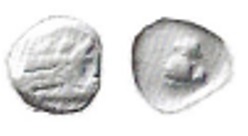Phaselis, silver, obols (500-440 BCE): Difference between revisions
From SILVER
m (Callatay moved page AC 261d - Phaselis, silver, obol to AC 261d - Phaselis, silver, obols (500-440 BCE)) |
m (Callatay moved page AC 261d - Phaselis, silver, obols (500-440 BCE) to Phaselis, silver, obols (500-440 BCE)) |
||
| (3 intermediate revisions by 2 users not shown) | |||
| Line 1: | Line 1: | ||
{{Die Study | {{Die Study | ||
|Image=AC261d Phaselis obols.jpg | |||
|Obverse description=Tern of galley right within incuse square. | |||
|Reverse description=Incuse square | |||
|Mint=Phaselis | |Mint=Phaselis | ||
|Ancient region=Lycia | |Ancient region=Lycia | ||
|Authority=Persian Empire | |||
|Date from=500 BCE | |Date from=500 BCE | ||
|Date to=440 BCE | |Date to=440 BCE | ||
| Line 7: | Line 11: | ||
|Metal=Silver | |Metal=Silver | ||
|Denomination=obol | |Denomination=obol | ||
|Median weight=0.75 | |||
|RQEM reference=RQMAC | |RQEM reference=RQMAC | ||
|RQEM reference number=261d | |RQEM reference number=261d | ||
|Die study reference= | |Die study reference=Heipp-Tamer 1993, Series 2, p. 131, n° 47-48 | ||
|Coin series reference=RQEMAC, n° 261d | |Coin series reference=RQEMAC, n° 261d | ||
|Coin series web reference=https://greekcoinage.org/iris/id/phaselis_heipp-tamer_1993_2 | |||
|Number of obverse dies=2 | |Number of obverse dies=2 | ||
|Number of singletons=1 | |||
|Number of reverse dies=2 | |Number of reverse dies=2 | ||
|Number of coins=3 | |Number of coins=3 | ||
|Workstation=Most likely one single workstation | |||
}} | |||
{{Distribution Item | |||
|Frequency=1 | |||
|Number of dies=1 | |||
|Die name=33 | |||
}} | |||
{{Distribution Item | |||
|Frequency=2 | |||
|Number of dies=1 | |||
|Die name=32 | |||
}} | }} | ||
Latest revision as of 05:13, 30 May 2023
500 BCE - 440 BCE Silver 72 kg
Description
| ObverseInscription or printing placed on the obverse.: | Tern of galley right within incuse square. |
| ReverseInscription or printing placed on the reverse.: | Incuse square |
Mint and issuing power
| MintIdentifies the place of manufacture or issue of a numismatic object.: | Phaselis | Ancient regionAncient region.: | Lycia | Modern countryModern country: Turkey | AuthorityIdentifies the issuing power. The authority can be "pretended" when the name or the portrait of X is on the coin but he/she was not the issuing power. It can also be "uncertain" when there is no mention of X on the coin but he/she was the issuing power according to the historical sources: | Persian Empire |
Chronology
| FromIdentifies the initial date in a range assigned in a numismatic context. | 500 BCE | toIdentifies the final date in a range assigned in a numismatic context.. | 440 BCE | PeriodTime period of the numismatic object.: Classical 480-323 BC |
Physical description
| MetalThe physical material (usually metal) from which an object is made.: | Silver |
Median weightMedian of the weights of numismatic objects (in grams). in grams | 0.75 | DenominationTerm indicating the value of a numismatic object. Examples: tetradrachm, chalkous, denarius.: | obol |
StandardStandard.: |
References
| Die study referencePublication of the study: | Heipp-Tamer 19931Heipp-Tamer 1993, Series 2, p. 131, n° 47-48 | ||
| Coin series referenceReference to coin series study: | RQEMAC2RQEMAC, n° 261d | ||
| Coin series web referenceCoin series web references: | |||
Obverse dies distribution
| FrequencyFrequency of specimen in distribution. ᵖ | Number of obversesNumber of obverse dies. ᵖ (o) | % (o) | Number of coinsNumber of coins. (n) | % (n) | Die nameName(s) of the die(s). |
| 1 | 1 | 50 | 1 | 33.33 | 33 |
| 2 | 1 | 50 | 2 | 66.67 | 32 |
| Total | 2 of 2 | 100 | 3 of 3 | 100 |
Reverse dies distribution
no distribution is available
Quantification
| Number of obversesNumber of obverse dies. ᵖ (o) | 2 | Number of singletons (o1)The number of singleton coins. ᵖ | 1 |
| Number of reverse diesNumber of reverse dies. (r) | 2 | Number of coinsNumber of coins. (n) | 3 |
| Coins per obverse dieNumber of coins per obverse die. (n/o) | 1.5 | Coins per reverse dieNumber of coins per reverse die. (n/r) | 1.5 |
| Reverse per obverse ratioRatio of obverse dies divided by reverse dies. (r/o) | 1 | Percentage of singletons (o1)number of coins (n) divided by the number of singletons (o1) ᵖ | 50 % |
| Original number of dies (O) (Carter 1983 formula)The estimation of the number of coins according to Carter 1983 ᵖ | 4.81 | Coins struck if 20,000 as average productivity per dieCoins made if the average productivity for obverses (according to Carter) is 20,000. ᵖ | 96,200 |
| Original number of dies (O) (Esty 2011 formula)The estimation of the number of coins according to the singleton formula in Esty 2011 ᵖ (O) | 6 | Survival rate if 20,000 as average productivity per dieSurvival rate if average productivity is 20,000. ᵖ | 0.00003 |
| Coverage (o = % of O) (Esty 1984 formula)Esty 1984 - coverage (% of O) ᵖ (o = % of O) | 66.67% | Die productivity if survival rate 1/2,000Average productivity if survival rate is 1/2,000. ᵖ | 1,247.4 |
| Weight of silver (in kg) if 20,000 coins per die (O = Carter formula)Carter 1983 * Median weight * 20000 (*10 if gold or electrum) ᵖ | 72 kg <br /> 72 kg | Die productivity if survival rate 1/5,000Average productivity if survival rate is 1/5,000. ᵖ | 3,118.5 |
Remarks
Most likely one single workstation
